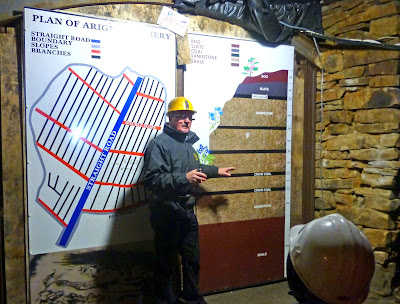Man of Arigna.
Black Spit. White Spit.
 |
| Following Jimmy underground |
Jimmy was our guide on our recent tour of the Arigna Mining Experience, a walking tour in what was Ireland's last working coal mine. Indeed, all the guides here are ex miners.
It was tough going but had its compensations, according to Jimmy. The big attraction was that those who worked at the coalface were well paid, more than teachers. “Three weeks wages would buy you a Honda 50 and a Honda 50 would get you a lady!”
 |
| A visitor sees the narrow seam of coal. |
That covered you from head to toe during your shift. All you could see of a miner as he clocked out was his eyes and his teeth. When he spat out coal-dust, the spit was black. But when he spat out the silicone dust, the spit was white. And it was the silica that led to the pre-mature death of many of the miners.
Jimmy spent thirteen years on the coal-face. Perhaps you needed a sense of humour. “A miner was a great catch. He was well paid and died young and she got the money.” It is often said: “There was money in Arigna when there was no money elsewhere”.
 |
| Jimmy explains how the workings of the mine |
This tour is one of the best you are likely to take. It takes you, hard hat and all, right to the heart of the coal-mining, right down to that narrow seam where the miner lay down to work. Imagine a coal seam of about 20 inches high, a yard or so in depth with a length of five to eight yards. This was your workplace for the shift. If you go there, you won't have to imagine it. You’ll see it right there.
 |
| That narrow seam again |
So you lay down there, sometimes in a couple of inches of water and worked the coal, shifting it out sideways. Your colleague loaded the wagon. When it was full, he attached his tag, and the wagon was hauled out by a rope system. Outside, the wagon was weighed and you were credited via the tag. You were paid by the weight. The shift finished when that five to eight yards of coal was cleaned out. Jimmy said a good pair of men would shift five tons a day, every day, five days a week.
 |
| Deep down |
Over two hundred thousand people had visited by June 2014. Why not go there while Jimmy and his colleagues are still there, “mad alive” as he says himself, to guide you. This is one of the best tour experiences I've ever had! Very Highly Recommended.
 |
| Lie down here to work. Cramped conditions. |
Comments
Post a Comment